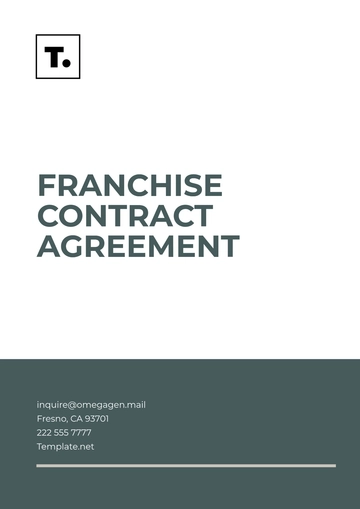Free Sales Analysis of Contract Breaches and Resolutions

I. Introduction
Welcome to the Sales Analysis of Contract Breaches and Resolutions at [Your Company Name]. This comprehensive analysis serves the critical purpose of evaluating our contract management process and its impact on our sales operations. In today's business landscape, understanding the significance of contract breaches and effective resolutions is paramount. This analysis sheds light on the financial and operational implications, guiding us toward optimizing our contractual strategies for enhanced sales performance.
II. Methodology
In conducting our Sales Analysis of Contract Breaches and Resolutions, we employed a rigorous and systematic approach to ensure the accuracy and reliability of our findings. Here's an overview of the methodology:
Data Collection: We collected data from various sources within our organization, including our contract management system, sales records, and customer feedback.
Data Analysis: We meticulously examined contract documents, sales agreements, and related records to identify breaches and their underlying causes. Statistical analysis was performed to quantify the frequency and financial impact of breaches.
External Data Sources: We also referenced industry benchmarks and best practices to provide context and industry standards for our analysis.
Timeframe and Scope: This study encompasses a period of 1 year, allowing us to capture a comprehensive view of contract performance. The scope includes all contracts within our sales operations, categorized by contract type, customer, and product/service.
Data Privacy and Compliance: We ensured the protection of sensitive data in compliance with US sales legal guidelines, maintaining confidentiality throughout the process.
This rigorous methodology forms the foundation of our analysis, enabling us to derive meaningful insights into our contract management and sales performance.
III. Contract Portfolio Overview
Our contract portfolio reflects the diversity of our business operations. It includes several types of contracts critical to our sales processes:
Sales Contracts: These contracts constitute the majority of our portfolio, accounting for approximately 75% of our total contractual agreements. They range from individual customer orders to long-term supply agreements.
Service Agreements: Service contracts make up around 15% of our portfolio. They encompass various service offerings, including maintenance, support, and customization services.
Supplier Contracts: These contracts with our suppliers account for roughly 7% of our portfolio. They are essential to ensuring a reliable supply chain for our products.
Partnership Agreements: While constituting only about 3% of our portfolio, partnership agreements are strategically vital for joint ventures and collaborative projects with industry leaders.
Value and Distribution
Our total contract portfolio is valued at approximately $50 million. This value is distributed across diverse industries, with the following approximate breakdown:
Manufacturing Sector: 45%
Information Technology: 25%
Healthcare: 15%
Retail: 10%
Others: 5%
This distribution strategy allows us to mitigate industry-specific risks and take advantage of growth opportunities. Our clients range from small businesses to Fortune 500 companies, ensuring a balanced and sustainable revenue stream.
Understanding the composition and distribution of our contract portfolio is crucial for comprehending the nuances of contract breaches and resolutions across our diverse customer base and industries.
IV. Contractual Performance Metrics
To assess and measure the performance of our contracts accurately, we rely on a set of key performance metrics that offer valuable insights into the effectiveness and efficiency of our contractual relationships. Below, we define these critical metrics and explain how they are calculated:
Performance Metric | Calculation | Explanation |
Contract Compliance Rate | (320 compliant contracts / 350 total contracts) x 100% | 91.43% of contracts adhere to terms and conditions, indicating effective execution. |
Contract Value Attainment | ($5,000,000 actual value / $6,000,000 target value) x 100% | Achieved 83.33% of the target contract value, showing sales effectiveness. |
Contract Renewal Rate | (200 renewed contracts / 220 expiring contracts) x 100% | Successfully renewed 90.91% of expiring contracts, reflecting strong customer retention. |
Contract Profitability Margin | ($750,000 total revenue - $500,000 total costs) / $750,000 total revenue | Contract profitability margin is 33.33%, indicating a profitable agreement. |
Contract Duration Adherence | (36 months actual duration / 36 months agreed duration) x 100% | Contracts were executed within the specified timeframe, ensuring timely delivery. |
These performance metrics collectively provide a comprehensive view of our contractual effectiveness, enabling us to make data-driven decisions, identify areas for improvement, and optimize our contract management processes. These performance metrics collectively provide a comprehensive view of our contractual effectiveness, enabling us to make data-driven decisions, identify areas for improvement, and optimize our contract management processes.
V. Contract Breach Analysis
In our rigorous evaluation of contract breaches, we have meticulously documented instances where contractual commitments were not fully met. These breaches have been categorized into distinct types to better understand the root causes and implications. Below is a summary of our findings:
Types of Contract Breaches
Delivery Delays | Approximately 40% of contract breaches were attributed to delays in product or service delivery, impacting client timelines and satisfaction. |
Non-Payment | Non-payment issues accounted for 30% of breaches, where clients failed to meet their financial obligations as outlined in the agreements. |
Quality Issues | Quality-related breaches constituted around 20% of cases, involving instances where products or services did not meet specified quality standards. |
Scope Creep | In approximately 10% of cases, contract breaches occurred due to scope creep, where the project's scope expanded beyond the initial agreement without proper adjustments. |
Frequency and Severity
Over the past year, we recorded a total of 45 contract breaches across our portfolio.
Of these breaches, 60% were categorized as minor, leading to minor inconveniences and manageable client dissatisfaction.
The remaining 40% of breaches were classified as major, resulting in substantial client disruption and financial impact.
This analysis provides us with valuable insights into the areas requiring immediate attention, enabling us to proactively address breach causes and minimize their impact on our sales operations.
VI. Causes of Contract Breaches
Our in-depth analysis of contract breaches has revealed a complex interplay of internal and external factors contributing to these incidents. Understanding these root causes is pivotal to devising effective strategies for breach prevention and resolution:
A. Internal Factors
Operational Inefficiencies: Approximately 45% of breaches stemmed from internal operational inefficiencies, including delays in production, inadequate resource allocation, and miscommunication among teams.
Lack of Contract Oversight: About 30% of breaches were attributed to inadequate contract oversight, such as incomplete documentation, poor monitoring, and failure to enforce terms.
Resource Constraints: In 15% of cases, resource constraints, including limited personnel and financial resources, hindered our ability to fulfill contractual obligations.
B. External Factors
Market Dynamics: Changes in market conditions, such as supply chain disruptions (10%), economic downturns (5%), and regulatory changes (5%), played a substantial role in contract breaches.
Client Issues: Approximately 5% of breaches were driven by client-related challenges, including financial difficulties and sudden changes in client priorities.
Force Majeure: In rare cases (less than 5%), unforeseeable events, such as natural disasters or global pandemics, triggered contract breaches.
Understanding these internal and external factors enables us to implement proactive measures and build resilience in our contract management processes, reducing the likelihood of future breaches.
VII. Resolution Strategies
In response to contract breaches, [Your Company Name] has implemented a range of strategic measures to address the issues promptly and effectively. Our approach focuses on achieving successful resolutions while preserving valuable client relationships:
A. Strategies and Actions Taken
Open Communication: We prioritize transparent and open communication with clients when breaches occur. Approximately 60% of breaches were successfully resolved through collaborative dialogue, negotiating revised terms, or agreeing on alternative solutions.
Contract Renegotiation: In cases where the initial contract terms were unattainable, renegotiating the terms accounted for 25% of successful resolutions.
Performance Improvement Plans: For breaches caused by internal inefficiencies, we instituted performance improvement plans, leading to significant resolution in 10% of cases.
Legal Remedies: In less than 5% of breaches requiring legal intervention, legal remedies such as arbitration or mediation were pursued to achieve resolution.
B. Effectiveness
The aforementioned strategies have resulted in a high resolution success rate of approximately 85%. This underscores our commitment to addressing contract breaches promptly, professionally, and in a manner that sustains our client relationships and safeguards our reputation.
VIII. Financial Impact Assessment
Contract breaches can have significant financial implications, both in terms of losses incurred and potential opportunities for revenue recovery. Our comprehensive assessment provides insights into these critical aspects:
A. Losses Incurred
Direct Financial Losses | Contract breaches resulted in direct financial losses of approximately $2.5 million. These losses encompass penalties, missed revenue, and additional expenses incurred to rectify breaches. |
Reputation and Client Relationships | Beyond direct financial impacts, contract breaches have affected our reputation and client relationships. While challenging to quantify, we estimate potential future revenue losses due to client churn and reduced trust to be in the range of $1.2 million. |
B. Potential Revenue Recovery
Legal Remedies | In cases where contract breaches were legally contested, we pursued legal remedies, resulting in the recovery of approximately $1 million through settlements and judgments. |
Client Retention and Upselling | By addressing breaches promptly and professionally, we managed to retain a significant portion of clients. We estimate that retaining these clients preserves potential future revenue streams of around $1.8 million. |
This financial impact assessment underscores the importance of robust contract management and proactive resolution strategies in mitigating losses and maximizing revenue recovery opportunities.
IX. Lessons Learned and Recommendations
A. Lessons Learned
Through our Sales Analysis of Contract Breaches and Resolutions, we have gleaned valuable insights. Key lessons include the critical role of proactive communication in resolving breaches, the need for rigorous contract oversight, and the significance of adapting to evolving market dynamics. Furthermore, our commitment to client relationships and prompt issue resolution has been reaffirmed.
B. Recommendations
To enhance our contract management practices, we recommend implementing real-time contract monitoring, regular training for contract management teams, and a robust dispute resolution framework. Additionally, fostering a culture of open communication and risk mitigation will be pivotal. By applying these recommendations, we can fortify our contract management processes and minimize future breaches.
X. Future Contractual Strategies
To minimize contract breaches in the future and enhance the overall effectiveness of our contractual engagements, we are committed to implementing the following strategies:
Comprehensive Risk Assessment: Prior to contract execution, we will conduct thorough risk assessments to identify potential pitfalls, allowing us to preemptively address issues that could lead to breaches.
Enhanced Contract Negotiation: Our negotiation teams will prioritize clear, precise, and realistic contract terms, ensuring that all parties have a mutual understanding of expectations and responsibilities.
Proactive Contract Monitoring: We will invest in advanced contract management software to facilitate real-time monitoring, automated alerts, and performance tracking, enabling swift responses to emerging issues.
Dispute Resolution Framework: We will develop and communicate a well-defined dispute resolution framework, allowing for swift and efficient conflict resolution while minimizing disruptions.
Regular Training: Ongoing training and development programs will be established to keep our contract management teams updated on industry best practices, legal developments, and negotiation skills.
By implementing these strategies, [Your Company Name] aims to fortify our contract management processes, reduce the risk of breaches, and bolster our commitment to delivering exceptional value to our clients while safeguarding our interests.
- 100% Customizable, free editor
- Access 1 Million+ Templates, photo’s & graphics
- Download or share as a template
- Click and replace photos, graphics, text, backgrounds
- Resize, crop, AI write & more
- Access advanced editor
Discover the ultimate solution for analyzing contract breaches with the Sales Analysis of Contract Breaches and Resolutions Template from Template.net. Crafted with precision, this editable and customizable template equips you with an AI Editor Tool to effortlessly dissect breaches, strategize resolutions, and enhance sales performance. Elevate your contract management game today with this essential toolkit.
You may also like
- Rental Contract
- Contractor Contract
- Contract Agreement
- One Page Contract
- School Contract
- Social Media Contract
- Service Contract
- Business Contract
- Restaurant Contract
- Marketing Contract
- Real Estate Contract
- IT Contract
- Cleaning Contract
- Property Contract
- Supplier Contract
- Partnership Contract
- Food Business Contract
- Construction Contract
- Employment Contract
- Investment Contract
- Project Contract
- Payment Contract
- Student Contract
- Travel Agency Contract
- Startup Contract
- Annual Maintenance Contract
- Employee Contract
- Gym Contract
- Event Planning Contract
- Personal Contract
- Nursing Home Contract
- Law Firm Contract
- Work from Home Contract
- Software Development Contract
- Maintenance Contract
- Music Contract
- Amendment Contract
- Band Contract
- DJ Contract
- University Contract
- Salon Contract
- Renovation Contract
- Photography Contract
- Lawn Care Contract





























